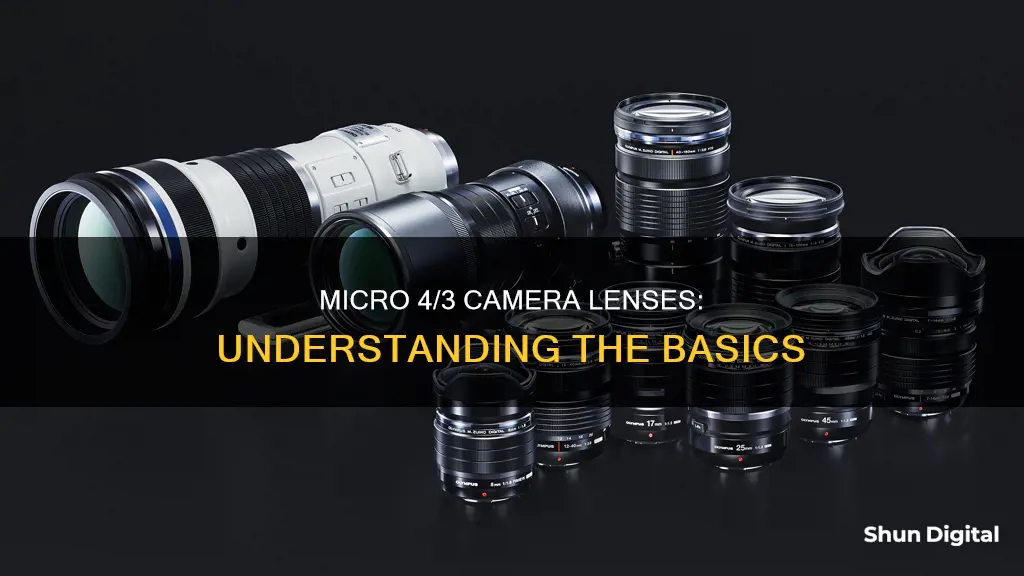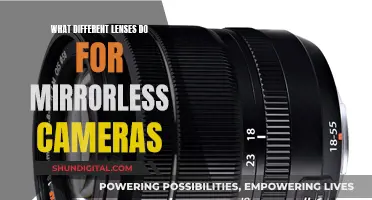
The Micro Four Thirds system (MFT or M4/3 or M43) is a standard released by Olympus Imaging Corporation and Panasonic in 2008 for the design and development of mirrorless interchangeable lens digital cameras, camcorders and lenses.
MFT lenses are produced by a range of manufacturers including Cosina Voigtländer, Kowa, Mitakon, Olympus, Panasonic, Samyang, Sigma, Tamron, and many others.
MFT cameras have better, larger sensors, and interchangeable lenses than compact digital cameras. They are also smaller and lighter than digital SLRs.
The MFT design standard specifies a bayonet-type lens mount with a flange focal distance of 19.25mm. This reduction facilitates smaller body and lens designs, and enables the use of adapters to fit almost any lens ever made for a camera with a flange distance larger than 19.25mm to an MFT camera body.
| Characteristics | Values |
|---|---|
| Micro Four Thirds system | MFT, M4/3, M43 |
| Released by | Olympus Imaging Corporation and Panasonic |
| Year of release | 2008 |
| Camera bodies available from | Blackmagic, DJI, JVC, Kodak, Olympus, OM System, Panasonic, Sharp, and Xiaomi |
| MFT lenses produced by | Cosina Voigtländer, Kowa, Kodak, Mitakon, Olympus, Panasonic, Samyang, Sharp, Sigma, SLR Magic, Tamron, Tokina, TTArtisan, Veydra, Xiaomi, Laowa, Yongnuo, Zonlai, Lensbaby, Venus Optics and 7artisans amongst others |
| Image sensor of Four Thirds and MFT | 18 mm × 13.5 mm (22.5 mm diagonal), with an imaging area of 17.3 mm × 13.0 mm (21.63 mm diagonal) |
| MFT design standard specifies a bayonet type lens mount with a | 19.25 mm flange focal distance |
| MFT cameras exclusively used | Contrast-detection autofocus (CDAF) |
| MFT cameras have | Smaller body and lens designs |
| MFT cameras can use | Almost any lens ever made for a camera with a flange distance larger than 19.25mm |
| MFT cameras are | Smaller and lighter than DSLRs |
| MFT cameras have | Sharper images at slower shutter speeds as a result of IBIS (In-Body Image Stabilization) common in Panasonic and Olympus Micro Four Thirds cameras |
| MFT cameras have | Larger crop factor (2x multiplier) |
What You'll Learn

Micro Four Thirds lenses are compatible with Panasonic and Olympus cameras
The Micro Four Thirds system, also known as MFT or M4/3, is a standard developed by Olympus and Panasonic in 2008 for mirrorless interchangeable lens cameras, camcorders, and lenses. This system offers several advantages over DSLR lenses, including smaller size, lighter weight, and lower prices.
MFT lenses are compatible with both Panasonic and Olympus cameras, regardless of the brand. This means photographers can choose from a wide range of third-party options or even use adapters for DSLR or mirrorless lenses. The compatibility of MFT lenses across different brands provides photographers with a wide range of options to choose from, making it a popular choice in the market.
The MFT system has a shorter flange focal distance of 19.25 mm, which facilitates smaller body and lens designs. This reduction in flange focal distance also enables the use of adapters, allowing photographers to use almost any lens with a flange distance larger than 19.25 mm on an MFT camera body. The shorter flange focal distance, along with the smaller sensor size, allows for more compact and lightweight lenses, making them easier to carry and more discreet.
MFT lenses are produced by various manufacturers, including Panasonic, Mitakon, Samyang, Sharp, Sigma, Tamron, Tokina, and Olympus. This wide range of options gives photographers the flexibility to choose lenses that best suit their needs and preferences.
In summary, the Micro Four Thirds system offers many benefits, including smaller size, lighter weight, and compatibility with Panasonic and Olympus cameras. The wide range of compatible lenses provides photographers with numerous options to choose from, making it a versatile and popular choice in the photography world.
Choosing the Right Camera Lens: Capturing Perfect Shots
You may want to see also

Micro Four Thirds lenses are interchangeable
Micro Four Thirds (MFT) is a standard for the design and development of mirrorless interchangeable lens digital cameras, camcorders and lenses. It was released in 2008 by the Olympus Imaging Corporation and Panasonic.
MFT lenses are produced by a wide range of manufacturers, including Cosina Voigtländer, Kowa, Kodak, Mitakon, Olympus, Panasonic, Samyang, Sharp, Sigma, SLR Magic, Tamron, Tokina, TTArtisan, Veydra, Xiaomi, Laowa, Yongnuo, Zonlai, Lensbaby, Venus Optics and 7artisans.
MFT lenses are interchangeable between cameras from different manufacturers. For example, Olympus and Panasonic lenses are interchangeable, and you can also use them on Blackmagic cameras.
However, if you mix and match lenses and cameras from different manufacturers, you may lose some advanced functionality such as optical image stabilisation (OIS) and in-body image stabilisation (IBIS).
RF Lenses: Which Cameras Are Compatible?
You may want to see also

Micro Four Thirds is the oldest mirrorless system
Micro Four Thirds (MFT) is the oldest mirrorless system, released in 2008 by Olympus Imaging Corporation and Panasonic. It is a standard for the design and development of mirrorless interchangeable lens digital cameras, camcorders and lenses. The MFT system inherits the original sensor format of the Four Thirds system, designed for DSLRs.
The MFT system has a 2x crop factor, meaning that the field of view of an MFT lens is the same as a full-frame lens with twice the focal length. For example, a 50mm lens on an MFT body would have a field of view equivalent to a 100mm lens on a full-frame camera. This allows for smaller, lighter and more affordable lenses.
The MFT system also has a shorter flange focal distance than DSLRs, which facilitates smaller body and lens designs, and enables the use of adapters to fit almost any lens with a flange distance larger than 19.25mm. This means that a large number of other lenses, even from the analogue film era, can be fitted using an adapter.
MFT cameras are generally smaller and lighter than DSLRs, making them easier to carry and more discreet. They also have shallower depth-of-field capabilities, which is desirable for landscape and macro shooting, as well as video shooting in low light conditions.
The MFT system is built on an alliance between Panasonic and OM System (formerly Olympus). The two firms produce lightweight cameras and lenses using the same lens mount, meaning that Panasonic Lumix G lenses are adapted for use on Olympus or OM System cameras, and vice versa.
Camera Lenses: Face Distortion and the Art of Photography
You may want to see also

Micro Four Thirds lenses are smaller and lighter than full-frame lenses
The Micro Four Thirds system (MFT or M4/3 or M43) is a standard released by Olympus Imaging Corporation and Panasonic in 2008. It is designed for mirrorless interchangeable lens digital cameras, camcorders and lenses.
Micro Four Thirds cameras use a different image sensor format than full-frame and APS-C cameras. The Micro Four Thirds sensor format used in MFT cameras is equivalent to a 2.0 crop factor when compared to a 35 mm film (full frame) camera. This means that the field of view of an MFT lens is the same as a full-frame lens with twice the focal length. For example, a 50 mm lens on an MFT body would have a field of view equivalent to a 100 mm lens on a full-frame camera.
The Micro Four Thirds system also has a shorter flange focal distance than DSLRs, which means that most Micro Four Thirds lenses are smaller and cheaper. The shorter flange focal distance facilitates smaller body and lens designs.
The smaller sensor (2x crop factor) of the Micro Four Thirds system allows for longer telephoto reach with smaller and lighter lenses. The smaller sensor size also gives a deeper depth of field for the same field of view and equivalent f-number.
The Micro Four Thirds system is particularly appealing for photographers who use telephoto lenses. These lenses have longer focal lengths, so they capture a narrower angle. They are ideal for photographing wildlife and for getting great shots of team sports from the sidelines or stands.
The Micro Four Thirds system includes a range of prime lenses that cover popular angles of view. Prime lenses, those with a fixed angle of view, are typically slimmer than zoom lenses and gather more light. Both Olympus and Panasonic offer relatively lightweight F1.8 and F1.7 lenses, many of which are priced under $400.
Overall, the Micro Four Thirds system offers smaller and lighter lenses than full-frame lenses, making them easier to carry and more discreet.
Why Updating Your Camera Lens Firmware is Essential
You may want to see also

Micro Four Thirds lenses are ideal for wildlife photography
The reduced flange focal distance also facilitates the use of adapters, allowing photographers to attach a wide range of lenses to their Micro Four Thirds cameras, including telephoto lenses that are ideal for wildlife photography. The shorter flange focal distance and smaller sensor size of Micro Four Thirds cameras result in a crop factor of 2.0, which provides greater telephoto reach than full-frame or APS-C cameras. This means that Micro Four Thirds lenses can be smaller and lighter while achieving the same field of view as longer lenses on larger format cameras. For example, a 400mm lens on a Micro Four Thirds camera provides the same angle of view as an 800mm lens on a full-frame camera.
In addition to their compact size and weight advantages, Micro Four Thirds lenses offer other benefits for wildlife photography. Many Micro Four Thirds cameras and lenses feature image stabilisation, either in-body or in the lens, which can help to reduce camera shake and blur in photographs. This is particularly useful for wildlife photography, as it allows photographers to use slower shutter speeds and lower ISOs in low-light conditions, resulting in cleaner images with less noise.
The contrast-detection autofocus system used in Micro Four Thirds cameras also has benefits for wildlife photography. While it was initially slower than the phase-detection systems used in DSLRs, improvements in technology have led to faster autofocus speeds that can rival or surpass those of DSLRs. This makes it easier to capture sharp images of fast-moving subjects, such as birds or mammals in motion.
Some Micro Four Thirds lenses that are well-suited for wildlife photography include the Panasonic Leica DG 100-400mm f/4-6.3, which offers a focal length range of 200-800mm equivalent and optical stabilisation, and the Olympus M.Zuiko 300mm f/4.0 IS Pro, a prime lens with a focal length of 600mm equivalent and built-in image stabilisation. For those on a budget, the Panasonic Lumix G 100-300mm f/4-5.6 II is a good option, offering a focal length range of 200-600mm equivalent and optical stabilisation at a more affordable price.
Understanding Camera Lenses: Capturing Perfect Shots with Different MM Lenses
You may want to see also







